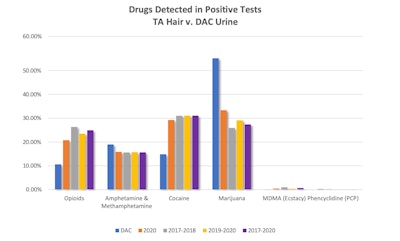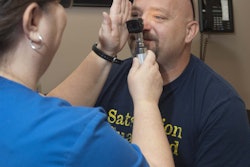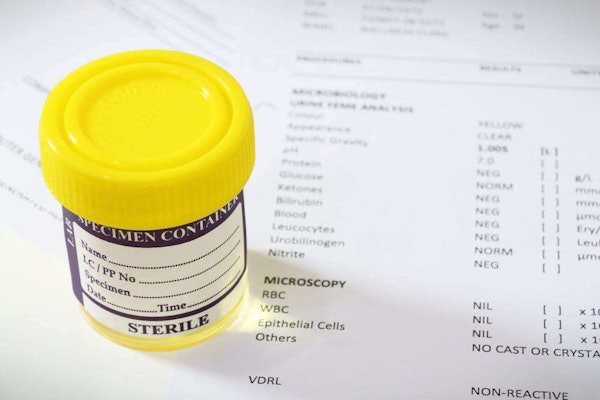
A new study from the Trucking Alliance and the University of Central Arkansas uses hair drug testing results from Trucking Alliance member carriers to suggest that drivers actually use cocaine more than marijuana, and that hair testing would essentially double the number of drivers disqualified for drug use.
The report, spearheaded by Trucking Alliance Managing Director Lane Kidd, looks at data from urine testing from the Drug and Alcohol Clearinghouse in December 2020 and compares it to four years of Trucking Alliance urine and hair testing results to advocate for the FMCSA allowing hair testing in lieu of urine testing, and to allow hair tests into the Clearinghouse record.
The Trucking Alliance, which was among large-fleet and other groups that successfully lobbied Congress to legislate the ELD mandate in 2012, also supported the FAST Act of 2015, which instructed the DOT to recognize hair testing. However, the Department of Health and Human Services has yet to write guidelines for implementation.
Trucking Alliance's new report intends to "continue to beat the drum and get some general public awareness that we do have a drug abuse problem in the trucking industry," said Lane Kidd, the group's managing director. "The big trucking associations don’t want to talk about it because they think it harms the image of the industry. But we're not trying to harm the industry's image, it's just a big public safety risk."

“Our research found that DOT is seriously under-reporting the actual use of harder drugs by truck drivers, such as cocaine and illegal opioids,” Doug Voss, professor of Logistics and Supply Chain Management at the University of Central Arkansas, wrote in a news release. “Our analysis clearly concludes that hair testing identifies these harder drugs at higher percentages than the single urine testing method relied on by the federal government.”
Trucking Alliance's conclusion – that hair testing yields more positive tests for hard drugs like cocaine, opioids and meth – draws on the fact that these drugs aren't observable in urine samples more than a few days after drug use, whereas marijuana metabolites can appear in urine samples for up to 30 days following usage.
Trucking Alliance then extrapolates the hair testing findings – which show cocaine use as slightly more common than marijuana among 288,495 mostly pre-employment hair tests conducted by member carriers – to the general trucking population of millions, using 2020's Drug and Alcohol Clearinghouse data as the comparison point.
Kidd argued that both urine testing and hair testing discovered marijuana use at near identical rates, but that hair testing showed a much higher rate of hard drug use, and that the Trucking Alliance's sample population had the same geographic profile as drivers at large. The study does assume, however, that the general driver population behaves the same as drivers who applied to Alliance member carriers including J.B. Hunt, Knight-Swift, Schneider, Maverick Transportation, U.S. Xpress and other major carriers from 2017 to 2020.
The Owner-Operator Independent Drivers Association took issue with the study, saying it's not peer-reviewed or scientifically sound.
“The report provides no meaningful insight or connections to improving highway safety and does not support the group’s proposal to mandate hair testing," OOIDA said through a spokesperson. "The minimal and disappointingly limited research has no scientific analysis, methodology, demographics, hypothesis or literature review. Hair testing is subject to environmental contamination and can be discriminatory toward African-American truck drivers. Highway safety policies should always be based upon sound research demonstrating a strong connection to a reduction in crashes."
Hair testing can uncover drug use for up to a 90 day period, and Kidd said that testing methodologies have improved over the last 30 years. Kidd said hair testing would pick up on "lifestyle drug users" and not occasional users, but that drivers who use illicit drugs like cocaine and opioids on their own time and in ways that don't appear on urine tests also should get reported to the Clearinghouse. Kidd also strongly pushed back on the claims of racial bias in hair testing.
Advocating for hair testing amid a "driver shortage"
In 2020, the FMCSA disqualified 54,955 commercial truck drivers for failing a urine test. Trucking Alliance's suggested methodology could see up to 58,910 (more than double the actual number) disqualified via hair testing.
At a time when the American Trucking Association says the industry lacks 80,000 drivers and may lack 160,000 by 2030, Kidd said that the push to more strictly enforce rules and disqualify drivers is simply putting safety first.
"There are segments of the industry that would just as soon look the other way and go ahead and require the drug user to operate the truck," said Kidd. "I can’t see how the two are even related," he said of drug testing and any driver shortage. "The industry needs to hire more drug-free people."
Kidd said that any one of the thousands of drivers who received positive hair tests from Trucking Alliance applicants, and a small number of active Alliance drivers, could seek employment elsewhere and other employers wouldn't have access to the hair testing data because it's not included in the Clearinghouse: "This is about trying to improve the system, improve the Clearinghouse, so that employers have a more accurate picture if this applicant is a lifestyle drug user."
In 2015, after the FAST Act passed, the National School Transportation Association questioned the efficacy of hair testing and said that financial relationships or incentives drive most hair testing advocacy.
Psychemedics, one of the country's leading hair testing labs, is a partner of the Trucking Alliance and supports the group financially, as do vendors and service providers in the trucking space including Aon, Freightliner, and Bendix.














